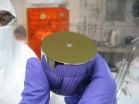(Press-News.org) A dark-matter experiment deep in the Soudan mine of Minnesota now has detected a seasonal signal variation similar to one an Italian experiment has been reporting for more than a decade.
The new seasonal variation, recorded by the Coherent Germanium Neutrino Technology (CoGeNT) experiment, is exactly what theoreticians had predicted if dark matter turned out to be what physicists call Weakly Interacting Massive Particles (WIMPs).
"We cannot call this a WIMP signal. It's just what you might expect from it," said Juan Collar, associate professor in physics at the University of Chicago. Collar and John Orrell of Pacific Northwest National Laboratory, who lead the CoGeNT collaboration, are submitting their results in two papers to Physical Review Letters.
WIMPS might have caused the signal variation, but it also might be a random fluctuation, a false reading sparked by the experimental apparatus itself or even some exotic new phenomenon in atomic physics, Collar said.
Dark matter accounts for nearly 90 percent of all matter in the universe, yet its identity remains one of the biggest mysteries of modern science. Although dark matter is invisible to telescopes, astronomers know it is there from the gravitational influence it exerts over galaxies.
Theorists had predicted that dark matter experiments would detect an annual modulation because of the relative motion of the Earth and sun with respect to the plane of the Milky Way galaxy.
The sun moves in the plane of the galaxy on the outskirts of one of its spiral arms at a speed of 220 kilometers per second (136 miles per second). The Earth orbits the sun at 30 kilometers per second (18.5 miles per second). During winter, Earth moves in roughly the opposite direction of the sun's movement through the galaxy, but during summer, their motion becomes nearly aligned in the same direction. This alignment increases Earth's net velocity through a galactic halo of dark matter particles, whose existence scientists have inferred from numerous astronomical observations.
Like a cloud of gnats
WIMPs would be moving in random directions in this halo, at velocities similar to the sun's. "You find yourself in a situation similar to a car moving through a cloud of gnats," Collar explained. "The faster the car goes, the more gnats will hit the front windshield."
CoGeNT seems to have detected an average of one WIMP particle interaction per day throughout its 15 months of operation, with a seasonal variation of approximately 16 percent. Energy measurements are consistent with a WIMP mass of approximately 6 to 10 times the mass of a proton.
These results could be consistent with those of the Italian DArk MAtter (DAMA) experiment, which has detected a seasonal modulation for years. "We are in the very unfortunate situation where you cannot tell if we are barely excluding DAMA or barely in agreement. We have to clarify that," Collar said.
In particle physics, he further cautioned, agreement between two or three experiments doesn't necessarily mean much. The pentaquark is a case in point. Early this century, approximately 10 experiments found hints of evidence for the pentaquark, a particle consisting of five quarks, when no other known particle had more than three. But as time went on, new experiments were unable to see it.
"It's just incredible," said UChicago physics Professor Jonathan Rosner. "People still speculate on whether it's real."
Collar and his colleagues have calculated the probability that their finding is a fluke to be five-tenths of a percent, or 2.8 sigma in particle physics parlance.
"It's not an exact science yet, unfortunately," Collar said. "But with the information we have, the usual set of assumptions that we make about the halo and these particles, their behavior in this halo, things seem to be what you would expect."
Other dark-matter experiments, including Xenon100, have not detected the seasonal signal that CoGeNT and DAMA have reported.
"If you really wanted to see an effect, you could argue that the Xenon100 people don't have the sensitivity to Juan's result," said Rosner, who is not a member of the CoGeNT collaboration. "On the other hand, they've done a number of studies of what their sensitivity is at low energies and they believe they're excluding this result."
Interrupted by fire
CoGeNT operated from December 2009 until interrupted by a fire in the Soudan mine in March 2011. Fifteen months of data collection is a relatively brief period for a dark-matter experiment. In fact, Collar and his colleagues decided to examine the data now only because the fire had stopped the experiment, at least temporarily.
The fire did not directly affect the experiment, but the CoGeNT team has not been able to examine the detector because of clean-up efforts. The detector may no longer work, or if it does work, it may now have different properties.
"This effect that we're seeing is touch-and-go. It's something where you have to keep the detector exquisitely stable," Collar said. If a single key characteristic of the detector has changed, such as its electronic noise, "We may be unable to look for this modulation with it from now on."
The putative mass of the WIMP particles that CoGeNT possibly has detected ranges from six to 10 billion electron volts, or approximately seven times the mass of a proton. "To look for WIMPs 10 times heavier is hard enough. If they're this light, it becomes a nightmare," Collar said.
INFORMATION:
Related links
Q&A with Juan Collar on the hunt for dark matter (June 6, 2011)
http://www.kavlifoundation.org/science-spotlights/chicago-dark-matter-modulation-collar
Dark matter search plunges physicists to new depths (Aug. 11, 2010)
http://news.uchicago.edu/article/2010/08/10/dark-matter-search-plunges-physicists-new-depths
New data still have scientists in dark over dark matter
2011-06-08
ELSE PRESS RELEASES FROM THIS DATE:
Heirloom Caribbean Real Estate Fund Enters Into Joint Venture to Develop Harbour Island, Antigua
2011-06-08
Heirloom Fund Management Ltd., manager of the Heirloom Caribbean Real Estate Fund (HCREF), is pleased to announce that it has entered into a joint venture partnership agreement with Stanhope Shepherd Ltd. HCREF will provide up to USD $50 million in debt and equity financing for the development of the Harbour Island Residences in Jolly Harbour, Antigua.
At the sod turning ceremony held last week, Antiguan Prime Minister Baldwin Spencer stated that this major project has the full support and backing of the Government of Antigua. Harbour Island is a 33 acre man-made island ...
Potential treatment for deadly E. coli disease
2011-06-08
A potential life-saving treatment for severe E. coli food poisoning outbreaks – developed more than a decade ago – hasn't gone forward into clinical trials because of lack of commercial interest.
University of Adelaide researchers produced a "designer" probiotic bacterium which binds and neutralises the toxin produced by E. coli, which causes life-threatening attack on the kidneys and blood vessels.
The team of scientists – Dr Adrienne Paton, Associate Professor Renato Morona and Professor James Paton – showed that mice infected with a highly virulent strain of E. coli ...
Study finds bankruptcy rates among cancer patients increase along with survival time
2011-06-08
CHICAGO — June 6, 2011 — An analysis linking federal bankruptcy court records to cancer registry data from nearly 232,000 adult cancer cases in western Washington during a 14-year period has found a hidden cost to survival: Insolvency rates increase along with the length of survival.
"Patients diagnosed with cancer may face significant financial stress due to income loss and out-of-pocket costs associated with their treatment," said Scott Ramsey, M.D., Ph.D., a health care economist and internist at Fred Hutchinson Cancer Research Center who led the study. "On average, ...
Prolonging life carries more weight
2011-06-08
Los Angeles, CA (May 26, 2011) Doctors are more apt to recommend a more costly therapy to patients if it were determined to prolong the patient's life rather than just improve quality, according to a recent study from Medical Decision Making (published by SAGE).
Using a survey of the decision-making process, authors were able obtain data to determine the relative importance oncologists place on quantity of life compared to quality of life in chemotherapy decisions. From this, they found a significant majority of respondents (71.8%) illustrated a greater value they placed ...
Many patients with advanced cancers get treatments that won't help
2011-06-08
A study of more than 1,000 patients with colon cancer that had spread to distant sites found that one in eight was treated with at least one drug regimen that was not recommended. Those patients were exposed to significant risk without proven benefits, at an estimated cost—just for the drugs—of more than $2 million.
The study, presented June 7, 2011, by University of Chicago researchers at the American Society for Clinical Oncology's annual meeting in Chicago, focused on three chemotherapy regimens that were not supported by evidence from prior clinical studies or clinical ...
33-country survey reports 50 percent increase in sustainably managed tropical forests
2011-06-08
BERN, SWITZERLAND (7 JUNE 2011)—A comprehensive assessment of tropical forest management reports a 50 percent increase in the area of tropical forest under sustainable management in just five years, but cautions that key drivers of that increase—growing demand for certified timber and funding for climate change initiatives—could have only a marginal impact in the long-term.
Drawing on detailed data on each of the 33 countries that together control almost all of the world's tropical rainforests and tropical timber production, the report released today by the Japan-based ...
Mapping anemia risk in preschool-age children in West Africa
2011-06-08
In this week's PLoS Medicine, Ricardo Soares Magalhães and Archie Clements, from the University of Queensland, Brisbane, Australia, describe how they used national cross-sectional household-based demographic health surveys to map the distribution of anaemia risk in preschool-age children in Burkina Faso, Ghana, and Mali. The use of such maps has significant practical implications for targeted control of anaemia in these countries, such as guiding the efficient allocation of nutrient supplements and fortified foods, and contributing to the planning and evaluation of resource ...
Coseasonality of influenza and invasive pneumococcal disease
2011-06-08
Using a combination of sophisticated modelling and statistical analyses, David Fisman and colleagues show that infection with influenza likely increases the incidence of invasive pneumococcal disease (IPD). It is feasible that infection with influenza increases the short-term risk of bacterial invasion in individuals already colonized with Streptococcus pneumoniae (which causes IPD) by increasing the permeability of the lining of the airways to the bacteria. These findings suggest that some cases of IPD could be attributable to influenza, so the extension of influenza ...
Health and safety of low-skilled workers should be priority for migration policy
2011-06-08
In the fourth article in a six-part PLoS Medicine series on migration & health, Joan Benach from the Employment Conditions Network at the Universitat Pompeu Fabra, Barcelona, Spain, and colleagues discuss the health risks and policy needs associated with migration to destination countries, especially for low-skilled workers. In destination countries, migrant workers often fill low- or semi-skilled positions in the labour market, which are often characterized by flexibility, insecurity, precarious employment, and long working hours with low pay. Undocumented or "illegal" ...
Finnish twin study yields new information on how fat cells cope with obesity
2011-06-08
The mechanisms by which obesity leads towards metabolic co-morbidities, such as diabetes mellitus, are poorly understood and of great public health interest. A study led by Matej Orešič from VTT Technical Research Centre of Finland suggests that adaptation of fat cell membranes to obesity may play a key role in the early stages of inflammatory disorders.
Millions of adults are diagnosed as obese each year, worldwide. Many of these people suffer from a disorder known as metabolic syndrome, which includes symptoms such as hypertension and elevated blood cholesterol. ...

